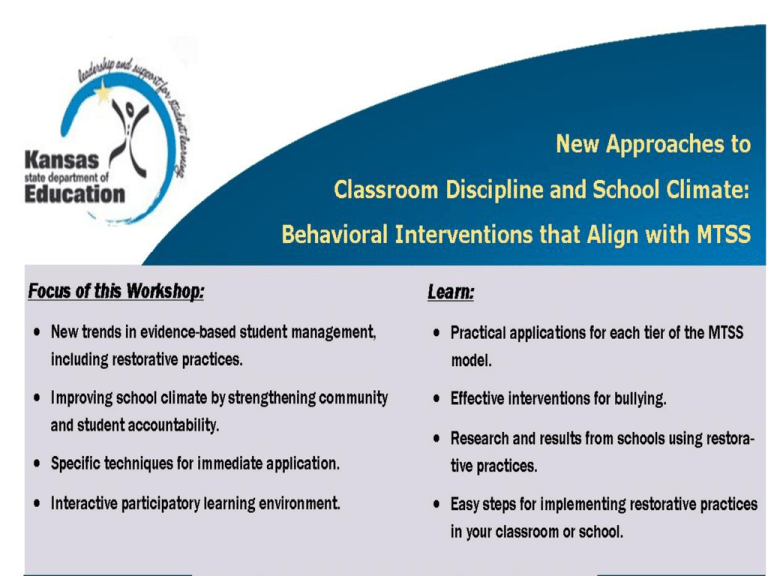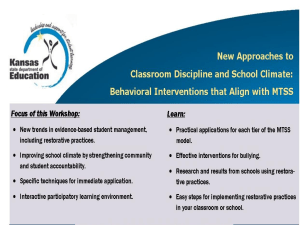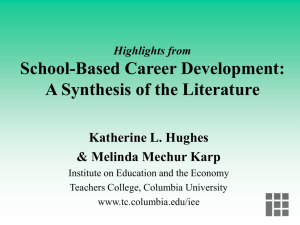Positive Discipline, MTSS, CBT.Baker
advertisement

State BOE Mission Statement The Mission of the State Board of Education is to prepare Kansas students for lifelong success through rigorous academic instruction, 21st century career training, and character development according to each student's gifts and talents. While teachers entertain a wide range of beliefs about discipline, beliefs may be placed into three broad categories…. What is your belief? Are you…. An Interventionists (where teachers use Rules/Rewards-Punishment)? Or A Non-Interventionists (where teachers value Human Relationships and Listening)? Or An Interactionalists (where teachers Confront, Contract and Negotiate)? Or A Transformationalist (where teachers Diversify, Differentiate and Ameliorate)? All four approaches are essential and teachers ideally blend skills from each approach to perfect a balanced disciplinary style. Which Model? Skinner Behavior Modification William Rogers Decisive Discipline Redl/Wattenberg Discipline in Group Dynamics Glasser Choice Theory (Reality Therapy) Canter Assertive Discipline Sprick Safe and Civil Schools Kounin Withitness and Organization Christian Moore WhyTry? Dreiker Mistaken Goals Carl Rogers Client Centered Therapy Culture and Climate Local Option Evidenced based MTSS alignment Staff and community involvement Progress monitoring Empower the culture Establish behavioral expectations early and revisit them throughout the year Positive Behavioral Supports Resiliency Repair the harm Positive Discipline Schools: ------------------------------------- Understand the quality of relationships and school climate are absolutely critical to successful student learning. (Engagement.) Establish strong meaning and connections for students, families and staff in social and academic contexts. (Engagement.) Implement principles of mutual respect and encouragement. (Character development.) Focus on long term solutions to misbehavior at individual, class and school wide levels. (Tiered approach.) View mistakes as opportunities to learn and misbehavior as opportunity to practice critical life skills. (Supplemental targeted skill intervention.) Question the validity and reliability of traditional adult control, rewards and punishments. (Evidenced based, client centered, repair the harm.) Kansas accreditation is: Character Development • Core Principles • Responsible Decision Making and Problem Solving • Social Awareness • Interpersonal Skills Social Skills Development • Self -Awareness • Self-Management Personal Skills Development Kansas Social, Emotional, and Character Education Standards Common Core Formatting Social, Emotional, Character Development Standards Strands Character Development Anchor Standards 1. Core Values 2. Responsible Decision Making And Problem Solving. Personal Development 1. Self-Awareness 2. Self-Management Social Development 1. Social Awareness 2. Interpersonal Skills (Big Ideas Across Grade-Levels) Grade-Level Standards K-2 / 3-5 / 6-8 / 9-12 K-2 / 3-5 / 6-8 / 9-12 Knowing Knowing Doing Doing K-2 / 3-5 / 6-8 / 9-12 Knowing Doing Tiered Approach Kansas Multi-Tiered System of Support (MTSS) Behavior • Student centered planning • Customized function-based interventions • Frequent progress monitoring to guide intervention design • Supplemental targeted function-based interventions • Small groups or individual support • Frequent progress monitoring to guide intervention design Academics • More intense supplemental targeted skill interventions • Customized interventions • Frequent progress monitoring to guide intervention design • • • Supplemental targeted skill interventions Small groups Frequent progress monitoring to guide intervention design • All students, All settings • Positive behavioral expectations explicitly taught and reinforced • Consistent approach to discipline • Assessment system and data-based decision making • All students • Evidence-based core curriculum & instruction • Assessment system and data-based decision making KSDE - July 2007 Draft Kansas Bullying Prevention Behavior Bullying Prevention • Student centered planning • Customized function-based interventions • Frequent progress monitoring to guide intervention design • Supplemental targeted function-based interventions • Small groups or individual support • Frequent progress monitoring to guide intervention design • More intense supplemental targeted skill interventions • Customized interventions/consequences/referrals/restorative practices • Frequent progress monitoring to guide intervention design • Supplemental targeted skill interventions • Small groups (restorative practices) • Frequent progress monitoring to guide intervention design • All students, All settings • Positive behavioral expectations explicitly taught and reinforced • Consistent approach to discipline • Assessment system and data-based decision making • All students, All settings; SECD • Evidence-based core curriculum & instruction • Assessment system and data-based decision making • Restorative practices KSDE – Nov. 2011 Draft SCHOOL COUNSELING PYRAMID OF INTERVENTION TIER 4 INTERVENTION SOURCES Targeted students participate in or receive services from government, non profits, and / or private agencies for Interventions to address chronic issues that impede learning. Examples: substance and addiction, foster care, juvenile justice system, mental health Assessments and use of data. Advocacy Teaming and collaboration TIER 3 SCHOOL COUNSELING PROGRAM INTERVENTION Targeted students participate in activities that are in addition to Tier 1 and Tier 2, but also include specific interventions designed for individual needs. Some examples: Grief counseling, referrals, crisis management Counseling, and solution focused counseling TIER 2 INTENTIONAL GUIDANCE AND COUNSELING: Targeted students participate in specific guidance and counseling activities that address the identified concerns. The identified concerns come from relevant data. Some data drivers: Interventions on discipline, achievement, attendance, mediation, conflict resolution and retention issues TIER 1 STANDARDS AND COMPETENCY BASED GUIDANCE AND COUNSELING PROGRAM Program Standards are provided to all students: Academic/Social/Emotional and Career Development Comprehensive School Counseling Model Kansas Department of Education Standards American School Counselors Association (ASCA) Kansas Department of Education • Dr. Alexa Posny Commissioner Guidance and Counseling Competencies. Guidance Curriculum Anti-bullying, Harassment & Intimidation Strategies ~5% Primary Prevention: School-/ClassroomWide Systems for All Students, Staff, & Settings ~15% Tertiary Prevention: Specialized Individualized Systems for Students with High-Risk Behavior Secondary Prevention: Specialized Group Systems for Students with At-Risk Behavior Anti-bullying, Harassment & Intimidation Strategies ~80% of Students 25 Use a Multi-Tier Approach KSDE School Counseling 26 Safe and Supportive Schools Levels of Intervention Condition for Learning Index Kansas Safe and Supportive Schools Continuum Conditions for Learning (CFL) Index Perceptual Control Theory Behavior is purposeful not just reactive (behaviorist) Behavior is the means by which we control our perceptions Perceptions are based on our frame of reference When perception and frame of reference are not in balance behavior is used to correct the imbalance Glasser’s Control theory Eight Steps • • • • • • • • Build a good relationship Examine the current behavior Evaluate behavior-helpful or not? Brainstorm alternatives Commit to new plan Evaluate results-no punish/excuses Accept logical & natural consequences Don’t get discouraged Engagement Process Five helpful questions What are you doing? Is it helping you get what you want? If not, what might be some other things you could try? Which idea would you like to try first? When would you like to start? Questions for young children • • • • • • What did you do? What is our rule about this? Was what you did against the rule? What were you supposed to do? What are you going to do next time? Do you want to write your plan for next time, or do you want me to write it? Brief counseling and Reality Therapy common components working alliance/collaboration identify strengths active counseling techniques: role play, homework, confrontation, reframing clear, concrete, measurable goals What Educators Can Do Stress student responsibility (class meetings). Establish rules that lead to success not those that stifle initiative, responsibility and self-direction. Accept no excuses. Call for value judgment. In a non-threatening tone ask “what are you doing” and “is it working?” Suggest suitable alternatives. Invoke reasonable consequences; encourage repairing any harm. Be persistent. Carry out continual review. WhyTry? Our wish for you! Heartland Elementary Blue Valley School District






